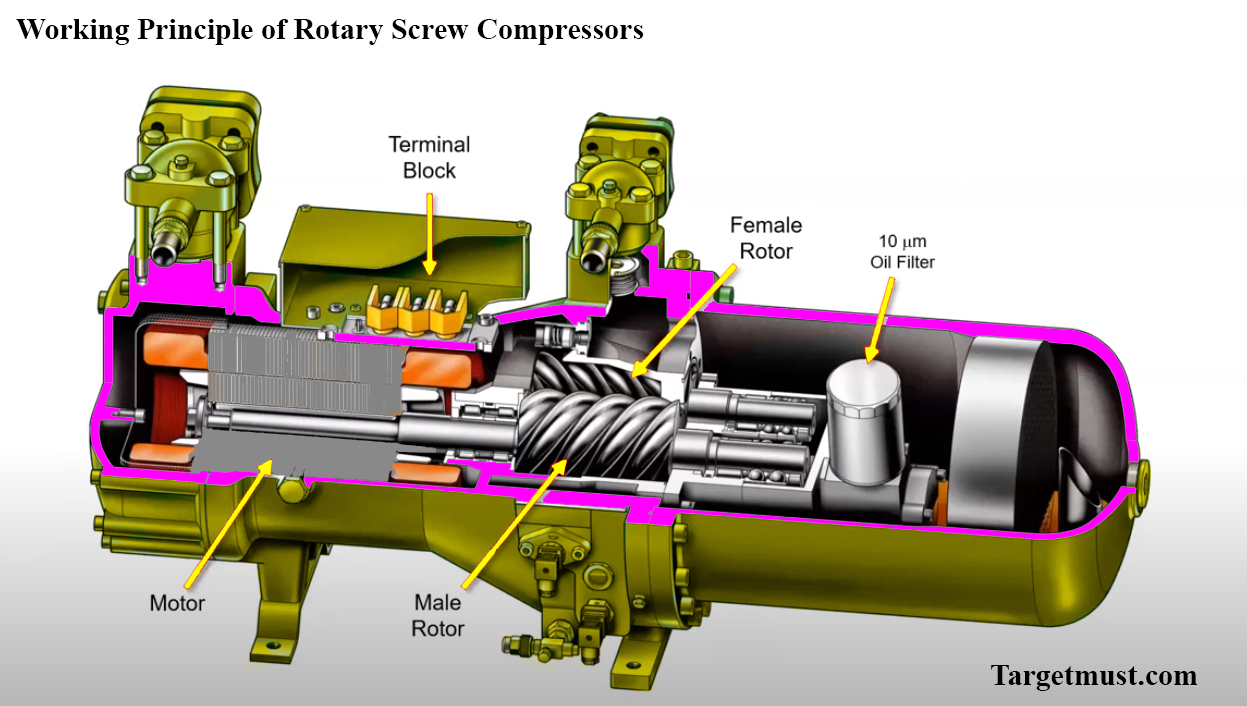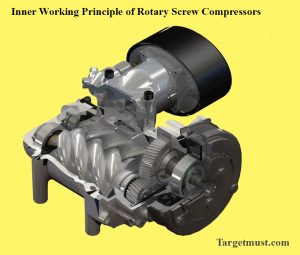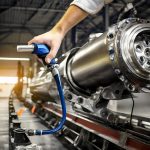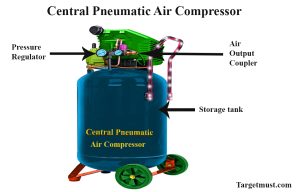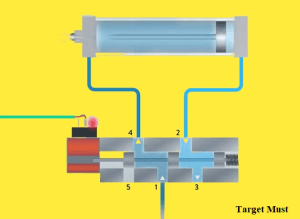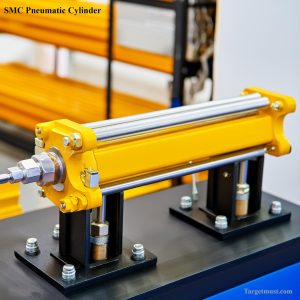What is the Working Principle of Rotary Screw Compressors?
Rotary screw compressors operate on the principle of two rotating helical screws compressing air. Air gets trapped between the rotors and gradually reduces in volume, leading to an increase in pressure. working principle of Rotary screw compressors This mechanism efficiently produces compressed air for various industrial applications.
Key Highlights
- Rotary screw compressors are a type of positive displacement compressor that use two rotors to compress air.
- They are known for their energy efficiency and are commonly used in industrial processes.
- The working principle of a rotary screw compressor involves the compression of air in a compression chamber.
- The core components of a rotary screw compressor include the screw element, air filter, and oil separator.
- There are two types of rotary screw compressors: oil-injected and oil-free systems.
- The compression process in a screw compressor involves the rotation of a male and female rotor in opposite directions.
- Oil-injected systems use oil for lubrication and cooling, while oil-free systems use timing gears for rotation.
- Rotary screw compressors are widely used in various industries, including manufacturing, energy, and agriculture.
- They offer advantages such as efficiency, reliability, and lower energy consumption.
- Routine maintenance and troubleshooting are essential for the proper functioning of rotary screw compressors.
- Technological advancements have led to innovations in rotary screw compressor technology.
Introduction
The screw compressor concept originated with the design of Swedish inventor AlfLysholm was patented when its practical use had not yet been found. Complex screw
It was difficult to produce with sufficient precision. Avoiding deformation, breakage and leakage. In 1954 Atlas Copco acquires the right to manufacture and sell its manufactured screw compressors. Lysholm principle, and in 1955 the first compressor was delivered to a Swedish company mine. LKAB.
After years of innovative research, only the first oil-injected screw compressor was used The screw element was brought to the market in 1958 by Atlas Copco. Atlas Copco introduced the Oil Free Compressor in 1967 to meet the need of the textile, food and pharmaceutical industries due to the absence of oil. When injected into the compression chamber, no oil remains in the compressed ARR. Oil free Compressor Atlas Copco expanded its market further.
working principle of Rotary screw compressors They are known for their energy efficiency, reliability, and ease of use. Understanding the working principle of screw compressors is essential for those considering their use in industrial processes.
we will delve into the working principle of rotary screw compressors, specifically how screw compressor work, the core components that make them function, and the different types available. We will also explore their applications across various industries and discuss the advantages they offer. Additionally, we will touch upon maintenance and troubleshooting tips to ensure the longevity and optimal performance of rotary screw compressors. Finally, we will discuss recent technological advancements in the field and their impact on screw compressor technology.
Whether you are new to the world of screw compressors or looking to expand your knowledge, this guide will provide you with valuable insights into the working principle and applications of rotary screw compressors.
Understanding Rotary Screw Compressors
Rotary screw compressors are a type of positive displacement compressor that is widely used in various industries. They operate based on the principle of compression, where the volume of air decreases to increase its pressure. Unlike other types of compressors, such as reciprocating or centrifugal compressors, rotary screw compressors deliver a continuous stream of compressed air, making them one of the easiest types of air compressors to use and maintain. working principle of Rotary screw compressors This makes them highly efficient and suitable for applications that require a constant supply of compressed air.
Definition and Basic Operation
The compression process takes place in a compression chamber, where the volume of air is reduced by the rotating motion of the screws. As the rotors rotate in opposite directions, they draw in air and compress it by decreasing the space between the rotors and the compression chamber.
This compression process results in an increase in air pressure. The compressed air is then discharged through an outlet valve for use in various industrial processes. working principle of Rotary screw compressors This type of compressor is often preferred over the reciprocating or piston compressor due to its ease of use and maintenance.
The basic operation of a rotary screw compressor involves the continuous rotation of the screws, which creates a continuous flow of compressed air. The moving parts of the compressor, including the rotors and bearings, play a critical role in maintaining smooth operation and efficient compression.
The Significance of Rotary Screw Technology in Compressors
Rotary screw technology plays a significant role in the efficiency and reliability of compressors. Unlike other compressor types, such as centrifugal compressors, which are classified as dynamic compressors, rotary screw compressors are classified as positive displacement compressors. This means that they deliver a constant volume of compressed air, making them highly efficient for industrial processes that require a steady supply of compressed air. With the demand for screw compressors increasing, it is important to understand the different technologies available and their unique benefits in order to choose the optimal solution for your needs.
The energy efficiency of rotary screw compressors is another important aspect. With their continuous operation and positive displacement mechanism, they can deliver compressed air with high efficiency, minimizing energy waste. This makes them ideal for applications where energy consumption is a concern, such as manufacturing and energy-intensive processes.
Overall, the significance of rotary screw technology in compressors lies in its ability to provide reliable and energy-efficient compressed air for a wide range of industrial processes.
Core Components of Rotary Screw Compressors
To understand the working principle of rotary screw compressors, it is essential to familiarize yourself with their core components. These components include the screw element, air filter, and oil separator.
The screw element is the heart of the rotary screw compressor. It consists of two interlocking screws (male and female) that rotate in opposite directions. The movement of these screws creates the compression action, drawing in and compressing the air.
The air filter is responsible for removing impurities, such as dust and debris, from the incoming air. It ensures that the compressor operates with clean air, reducing the risk of damage to the internal components.
The oil separator is used in oil-injected screw compressors to separate the oil from the compressed air. It ensures that the compressed air is free from oil contaminants, making it suitable for applications that require clean, oil-free air.
These core components work together to ensure the efficient and reliable operation of rotary screw compressors.
The Role of Screws in Compression
The screws in a rotary screw compressor play a crucial role in the compression of air. The compressor consists of a male rotor and a female rotor that interlock and rotate in opposite directions. working principle of Rotary screw compressors These helical screws create chambers between them, which gradually decrease in size as they rotate.
As the screws rotate, they draw in air from the inlet and trap it in the compression chambers. The rotation and interlocking action of the screws compress the air by reducing its volume decreases. This compression action results in an increase in air pressure. The compressed air is then discharged through the outlet valve for use in various industrial processes.
The design of the screws, including their pitch and length, determines the compression ratio and the efficiency of the compressor. The proper alignment and meshing of the screws are essential for optimal compression and reliable operation.
Oil-injected vs. Oil-free Systems
When it comes to rotary screw compressors, there are two main types: oil-injected and oil-free systems. The key difference between these systems lies in the presence of oil in the compression process.
In oil-injected systems, oil is injected into the compression chamber to lubricate and cool the mating screws. The oil also acts as a seal to prevent leakage and contamination. Oil-injected compressors can achieve higher pressures (psig) compared to oil-free systems and are commonly used in applications that require higher pressures. However, the compressed air from oil-injected systems contains traces of oil, which may not be suitable for certain sensitive applications. working principle of Rotary screw compressors On the other hand, oil-free screw compressors generally have lower psig but keep the compressed air free of contamination, making them highly desirable for industries such as food-grade and pharmaceuticals.
On the other hand, oil-free systems use timing gears to rotate the screws, eliminating the need for oil in the compression chamber. This makes the compressed air completely oil-free and suitable for applications that require clean, oil-free air. Oil-free compressors are commonly used in industries such as food processing, pharmaceuticals, and electronics, where purity is crucial. The basic difference between oil-injected and oil-free systems is the use of oil in the compression process. While oil-injected systems use oil for lubrication and cooling, oil-free systems do not require any oil in the compression chamber. This makes oil-free compressors more suitable for industries that require clean, oil-free air.
The following table provides a comparison between oil-injected and oil-free systems:
|
System Type |
Presence of Oil |
Maximum Pressure (psig) |
|
Oil-injected |
Yes |
Higher |
|
Oil-free |
No |
Lower |
Understanding the differences between oil-injected and oil-free systems is important when choosing the right rotary screw compressor for specific applications.
Readmore >>>>> Working principle of centrifugal air compressor
How Rotary Screw Compressors Work
To understand how rotary screw compressors work, it is important to grasp the basic principles of compression. The compression process involves reducing the volume of air to increase its pressure.
In a rotary screw compressor, the compression process begins with the rotation of the interlocking screws (male and female). As the screws rotate, they create chambers between them that gradually decrease in size. working principle of Rotary screw compressors This reduction in volume compresses the air, resulting in an increase in pressure. The pitch of the screw elements, as well as the form of the discharge port, play a crucial role in determining the built-in pressure ratio and the overall efficiency of the compressor. The compressed air is then discharged through the outlet valve for use in various industrial processes.
The continuous rotation of the screws ensures a constant flow of compressed air, making rotary screw compressors highly efficient and suitable for applications that require a steady supply of compressed air.
The Compression Cycle Explained
The compression cycle in a rotary screw compressor consists of several stages that contribute to the efficient compression of air. Let’s explore each stage of the compression cycle:
- Suction Stage: The suction stage begins with the opening of the suction valve, allowing atmospheric air to enter the compression chamber. The volume of the chamber increases as the screws rotate, drawing in the air.
- Compression Stage: As the screws continue to rotate, the volume of the chambers decreases, compressing the air. This compression stage increases the pressure of the air.
- Discharge Stage: Once the compression stage is complete, the compressed air is discharged through the outlet valve for use in industrial processes. The compression process is continuous, ensuring a steady supply of compressed air.
The compression cycle in a rotary screw compressor is a continuous process, allowing for efficient and reliable compression of air.
From Atmospheric Air to Compressed Air
The journey from atmospheric air to compressed air in a rotary screw compressor involves several stages. It begins with the intake of atmospheric air through the suction valve. This air is at a relatively low pressure, typically at or near atmospheric pressure.
As the air enters the compression chamber, the rotating screws gradually decrease the volume of the chamber. working principle of Rotary screw compressors This reduction in volume leads to an increase in air pressure. The compression process continues until the desired pressure is achieved.
Once the air is sufficiently compressed through the air compression cycle, it is discharged through the outlet valve as compressed air. The pressure of the compressed air depends on the specific requirements of the industrial process for which it is intended. Rotary screw compressors are capable of generating high pressures, making them suitable for a wide range of applications in industries such as automotive, semiconductor, and electronics.
Types of Rotary Screw Compressors
Rotary screw compressors come in various types to cater to different industrial needs. The two main types of rotary screw compressors are single-stage and two-stage compressors.
Single-stage compressors compress the air in a single step, delivering the desired pressure in one compression stage. working principle of Rotary screw compressors They are commonly used for applications that do not require extremely high pressures.
On the other hand, two-stage compressors have two compression stages. In the first stage, the air is partially compressed, and in the second stage, it undergoes further compression to achieve the desired pressure. Two-stage compressors are ideal for applications that require higher pressures.
Another type of rotary screw compressor is the variable speed drive (VSD) compressor. VSD compressors offer the flexibility of adjusting the compressor’s speed and capacity according to the demand for compressed air. This results in energy savings and increased efficiency, especially in applications with varying air demand.
The choice between single-stage, two-stage, and variable speed drive compressors depends on the specific requirements of the industrial process and the desired level of control and efficiency.
Single-stage vs. Two-stage Compressors
The choice between single-stage and two-stage rotary screw compressors depends on the required pressure and the efficiency desired.
Single-stage compressors compress the air in a single step, delivering the desired pressure in one compression stage. They are commonly used for applications that do not require extremely high pressures. However, single-stage compressors may have higher volumetric losses due to the compression process occurring in a single stage.
Two-stage compressors, on the other hand, have two compression stages. In the first stage, the air is partially compressed, and in the second stage, it undergoes further compression to achieve the desired pressure. Two-stage compressors are capable of delivering higher pressures and often have lower volumetric losses compared to single-stage compressors.
The choice between single-stage and two-stage compressors depends on the specific requirements of the industrial process, including the desired pressure and the level of efficiency desired.
Fixed Speed vs. Variable Speed Drive (VSD)
Fixed speed compressors and variable speed drive (VSD) compressors offer different levels of control and efficiency.
Fixed speed compressors run at a continuous fixed speed, delivering a constant flow of compressed air. working principle of Rotary screw compressors They are efficient when continuously operating at 100% capacity. However, in facilities with fluctuating flow demand throughout the day, fixed speed compressors may result in energy waste and inefficiency during periods of low demand.
Variable speed drive compressors (VSD), also known as variable frequency drive compressors, allow for the adjustment of the compressor’s speed and capacity according to the demand for compressed air. This flexibility results in energy savings and increased efficiency, especially in applications with varying air demand. VSD compressors automatically adjust their speed to match the required flow, ensuring optimal energy efficiency. This type of air compressor, compared to fixed-speed models, is especially handy for slow production days, breaks in workflow, or throughout second and third skeleton shifts, as it saves electricity and money.
The choice between fixed speed and variable speed drive compressors depends on the specific needs of the industrial process and the desired level of energy efficiency and control.
Applications of Rotary Screw Compressors
Rotary screw compressors find extensive applications in various industries due to their reliability, efficiency, and versatility. working principle of Rotary screw compressors Some of the common applications of rotary screw compressors include:
- Manufacturing: Screw compressors power a wide range of manufacturing processes, including pneumatic tools, assembly lines, and equipment cleaning.
- Energy: Rotary screw compressors are used in the energy sector for applications such as gas lift, pipeline maintenance, and equipment purging.
- Food Packaging: Screw compressors provide compressed air for food packaging processes, including blow molding, product sorting, and gas flushing.
- Agriculture: Rotary screw compressors power heavy agricultural equipment such as tractors, pumps, and conveyors.
These are just a few examples of the many industrial uses of rotary screw compressors. Their versatility and reliability make them a popular choice in various sectors.
Industrial Uses Across Various Sectors
Rotary screw compressors are widely used in various industries due to their reliability, efficiency, and versatility. working principle of Rotary screw compressors They have become an integral part of many industrial processes, ensuring a constant supply of compressed air. Some of the sectors that heavily rely on rotary screw compressors include:
- Manufacturing: Screw compressors power a wide range of manufacturing processes, including pneumatic tools, assembly lines, and equipment cleaning.
- Energy: Rotary screw compressors are used in the energy sector for applications such as gas lift, pipeline maintenance, and equipment purging.
- Food Packaging: Screw compressors provide compressed air for food packaging processes, including blow molding, product sorting, and gas flushing.
- Agriculture: Rotary screw compressors power heavy agricultural equipment such as tractors, pumps, and conveyors.
- Construction: Screw compressors are used in construction for operating heavy-duty tools such as jack-hammers, pneumatic tools, and sandblasters.
These are just a few examples of the many industrial sectors that rely on rotary screw compressors for their compressed air needs. The versatility and reliability of rotary screw compressors make them an essential component in various industrial processes.
Readmore >>>>> Maximizing Efficiency: Best Practices for Operating Your kobalt 26 gallon air compressor
The Importance in Energy, Manufacturing, and More
The use of rotary screw compressors in various industries is of great importance due to their energy efficiency and reliability. working principle of Rotary screw compressors They offer several advantages that make them the optimal solution for many applications.
Their continuous operation and positive displacement mechanism, they can deliver compressed air with high efficiency, minimizing energy waste. This is particularly important in energy-intensive industries where energy costs are a significant concern.
Rotary screw compressors also offer optimal solutions for industrial processes that require a constant supply of compressed air. Their reliability ensures uninterrupted operation, minimizing downtime and increasing productivity.
Furthermore, rotary screw compressors help reduce mechanical losses, ensuring smooth operation and longevity. With routine maintenance and proper troubleshooting, they can provide reliable compressed air for a wide range of industrial applications.
Advantages of Using Rotary Screw Compressors
Rotary screw compressors offer several advantages over other types of compressors. working principle of Rotary screw compressors Some of the key advantages include:
Efficiency and Reliability: Rotary screw compressors are known for their efficiency and reliability. With their continuous operation and positive displacement mechanism, they can deliver compressed air with high efficiency, minimizing energy waste. Their reliability ensures uninterrupted operation, minimizing downtime and increasing productivity.
Lower Energy Consumption and Operational Costs: Designed to provide compressed air with lower energy consumption, resulting in cost savings. Their energy-efficient operation makes them a preferred choice in industries where energy costs are a significant concern.
These advantages make a popular choice in various industries that rely on compressed air for their operations.
Efficiency and Reliability
Efficiency and reliability are key advantages of using . These compressors are designed to operate with maximum efficiency, delivering compressed air with minimal energy waste.
Rotary screw compressors can operate continuously for long periods of time, ensuring a constant supply of compressed air. Their positive displacement mechanism and robust design make them reliable and suitable for industrial processes that require uninterrupted operation.
One factor that contributes to the efficiency and reliability of is the limiting temperature difference. By controlling the temperature difference between the inlet and discharge, the efficiency of the compressor can be maximized. This ensures optimal operation and minimizes energy losses.
Overall, the efficiency and reliability of make them a preferred choice in various industries that rely on compressed air for their operations.
Lower Energy Consumption and Operational Costs
One of the significant advantages of is their lower energy consumption, resulting in cost savings. working principle of Rotary screw compressors These compressors are designed to provide compressed air with high efficiency, minimizing energy waste.
The energy efficiency of is achieved through their continuous operation and positive displacement mechanism. Unlike other compressor types that may experience energy losses during start-stop cycles, operate continuously, ensuring optimal energy utilisation.
Lower energy consumption translates to lower operational costs for industries that rely on compressed air for their processes. By choosing rotary screw compressors, businesses can reduce their energy expenses and improve their overall operational efficiency.
However, it is worth noting that the initial investment cost for may be higher compared to other compressor types. But the long-term savings in energy consumption and operational costs make them a cost-effective choice for many industries.
Maintenance and Troubleshooting
Routine maintenance and troubleshooting are essential for the proper functioning of . working principle of Rotary screw compressors Regular maintenance helps ensure optimal performance, prolongs the compressor’s lifespan, and prevents costly breakdowns.
Routine maintenance tips for include:
- Regularly inspecting and cleaning the compressor housing to remove any debris or dust buildup.
- Checking and replacing the air and oil filters as needed to maintain clean and efficient operation.
- Monitoring the compressor’s oil level and quality and performing regular oil changes.
- Checking for and addressing any internal leakage to prevent energy losses and maintain efficiency.
Common issues that may arise with include harmonic running, internal leakage, and troubleshooting mechanical and electrical components. Prompt identification and resolution of these issues through proper troubleshooting can help prevent major breakdowns and minimize downtime.
By following routine maintenance practices and addressing common issues promptly, businesses can ensure the reliable and efficient operation of their rotary screw compressors.
Readmore >>>>>> How to Properly Maintain Your Superflow Air Compressor for Longevity
Routine Maintenance Tips
working principle of Rotary screw compressors Here are some maintenance tips to ensure the reliable operation of your compressor:
- Regularly inspect and clean the compressor housing to remove any debris or dust buildup.
- Check and replace the air filter as needed to ensure clean air intake. A clogged or dirty air filter can restrict airflow and decrease compressor efficiency.
- Monitor the oil level and quality regularly. Ensure that the compressor’s oil level is within the recommended range and that the oil is free from contaminants. Perform regular oil changes to maintain proper lubrication and cooling.
- Check for any signs of internal leakage, such as oil or air leaks. Internal leakage can result in energy losses and decreased efficiency. Promptly address any leakage issues to maintain optimal performance.
By following these routine maintenance tips, you can ensure the reliable operation and longevity of your rotary screw compressor.
Common Issues and How to Solve Them
Rotary screw compressors may experience common issues that can affect their performance. working principle of Rotary screw compressors However, with proper troubleshooting and timely resolution, these issues can be resolved.
- Harmonic Running: If the compressor is running with excessive noise or vibrations, it could indicate harmonic running. This issue can be resolved by checking the alignment of the rotor and adjusting it if necessary.
- Internal Leakage: Internal leakage can result in energy losses and decreased efficiency. Regularly inspect the compressor for any signs of oil or air leaks. Address any internal leakage promptly by replacing faulty gaskets or seals.
- Troubleshooting Mechanical and Electrical Components: If the compressor is not operating as expected, it is important to troubleshoot the mechanical and electrical components. Check for any loose or damaged parts and repair or replace them accordingly.
By addressing these common issues through proper troubleshooting, you can ensure the reliable and efficient operation of your rotary screw compressor.
Innovations in Rotary Screw Compressor Technology
Technological advancements have led to innovations in compressor technology, working principle of Rotary screw compressors improving their efficiency and performance. These innovations have resulted in more reliable and energy-efficient compressors.
Recent developments in technology include:
- Asymmetric screw profiles: Modern, high-speed, oil-free screw compressors feature asymmetric screw profiles. This design improves energy efficiency by reducing internal leakage.
- External gear synchronization: External gears are commonly used to synchronize the position of counter-rotating rotors. This ensures smooth operation and prevents contact between the rotors and the compressor housing.
- Multiple stages and interstage cooling: Oil-free screw compressors frequently work in several stages and incorporate interstage cooling to achieve higher pressures and maintain efficiency.
These technological advancements have contributed to the popularity of in various industries, offering improved energy efficiency, reliability, and performance.
Recent Developments and Future Trends
Rotary screw compressors have gained great popularity due to their efficiency, reliability, and versatility. Recent developments in screw compressor technology have focused on improving energy efficiency, reducing maintenance requirements, and enhancing overall performance.
Future trends in technology may include:
- Enhanced energy efficiency through advanced control systems and improved screw designs.
- Integration of IoT (Internet of Things) technology for remote monitoring and troubleshooting.
- Continued development of oil-free screw compressors for applications that require clean, oil-free air.
- Development of more compact and lightweight compressors to meet space and mobility requirements.
These future trends and technological advancements will further enhance the efficiency and reliability of , making them an even more attractive choice for various industrial applications.
The Impact of Technological Advancements
Technological advancements in rotary screw compressor technology have had a significant impact on the industry. These advancements have brought about improvements in energy efficiency, reliability, and overall performance.
One of the key impacts of technological advancements is the increased energy efficiency of . Innovations in screw design, control systems, and cooling methods have contributed to higher efficiency and reduced energy consumption.
Additionally, technological advancements have improved the reliability and durability of . Developments in materials, lubrication systems, and component design have resulted in more robust and long-lasting compressors.
Furthermore, technological advancements have led to innovations in the field of dynamic compressors, such as centrifugal compressors. These innovations have offered alternatives to in certain applications, providing more options and flexibility in compressor selection.
Overall, the impact of technological advancements has been instrumental in making more efficient, reliable, and versatile.
Conclusion
In conclusion, understanding the working principle of screw compressors is crucial for various industries. Rotary screw technology plays a significant role in providing efficient and reliable compressed air for different applications. By grasping the core components, compression cycle, types, and advantages of rotary screw compressors, you can make informed decisions for your operational needs. Regular maintenance, troubleshooting, and staying updated on technological innovations are key to maximizing the lifespan and performance of these compressors. Whether it’s energy efficiency, lower operational costs, or industrial uses, screw compressors continue to be indispensable assets in the realm of compressed air systems.
Frequently Asked Questions
How Long Do Rotary Screw Compressors Last?
The lifespan of a varies depending on several factors, including maintenance, operating conditions, and the quality of the compressor itself. With proper maintenance and care, a well-maintained can last for 10-15 years or more. However, it is important to note that regular maintenance, including oil changes, filter replacements, and inspections, is crucial for ensuring the longevity and optimal performance of the compressor.

